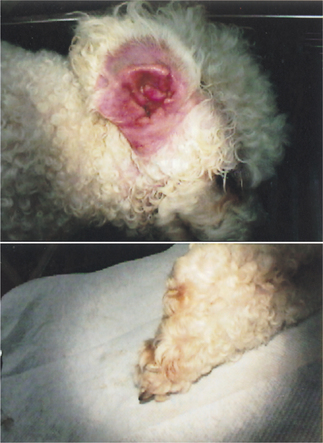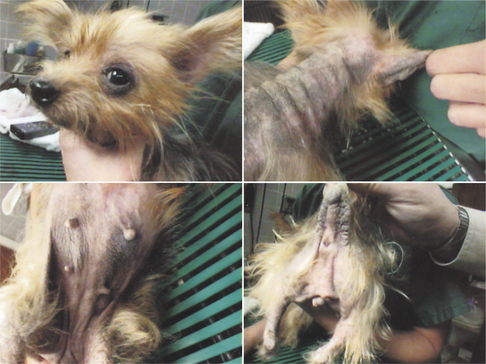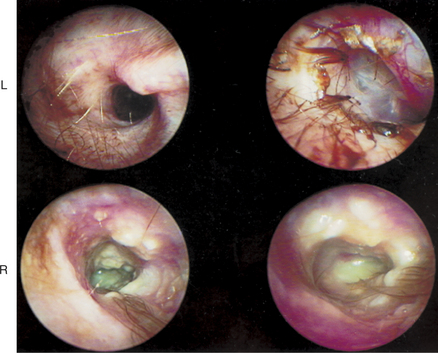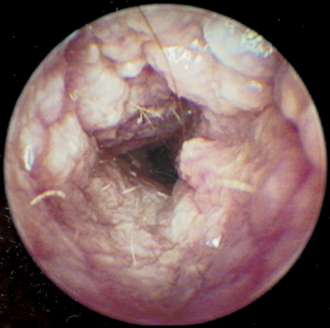Chapter 8 Perpetuating Factors and Treatment of Otitis Externa
Otitis externa is a common malady, occurring in 15% to 20% of dogs and 5% to 7% of cats seen in veterinary practice. Otitis externa is also one of the most frustrating diseases for veterinarians and owners to treat effectively. Treatment regimens vary widely, and a myriad of products containing a variety of ingredients are available for the treatment of ear disease.
In addition, dermatologic conditions often affect the ear canal, making it susceptible to otitis externa. The ear canal is an invagination of epidermis forming a hollow skin tube inside the head; it begins at the eardrum. Pathologic mechanisms affecting the skin of the animal also affect the epithelial tube lining the ear canal. For example, a dog with atopy may also show inflammation of the ear canal, resulting in redness, swelling, heat, and pain (Figures 8-1 and 8-2). In a cylindrical tube such as the ear canal, inflammation decreases the lumen diameter, tending to reduce both the ventilation and drying of the ear canal. Without ventilation, the humidity level of the ear canal rises, a factor favorable for bacterial growth.
Papules, pustules, crusts, ulcers, and alopecia that may occur on the skin of the trunk may also occur on the skin of the ear canal. Because the ear canal is L-shaped, exudates from these lesions tend to accumulate in the horizontal portion of the ear canal (Figure 8-3). In the treatment of skin disease, shampoo therapy, using a variety of compounds formulated for specific purposes, acts to remove irritating substances and improve healing. In the ear canal, ear flushing solutions containing a variety of ingredients are also used for adjunctive therapy of disease of the ear canal.
New approaches to the medical management of otitis externa in dogs and cats have now been introduced. They include (1) cytologic evaluation of exudates to identify disease processes and determine the type of disease organisms that may be present; (2) flushing products to remove exudates and to disinfect the canal epithelium; and (3) elucidations of pathophysiologic mechanisms showing that otitis externa is a secondary manifestation of underlying skin disease. New combinations of topical medications have been formulated to be effective against bacteria, fungi, and inflammation. The fluoroquinolone antibiotics, injectable ivermectin, and topical fipronil for ear mite infestations have reduced the use of potentially ototoxic antibiotics, oils, and insecticides in the ear canal.
Cytologic Evaluation
Obtaining samples and preparing a slide to examine constitute a simple procedure that should be a part of the minimum approach to every case of otitis presented to the veterinarian. A sample is obtained with the use of a small cotton-tipped applicator. The swab is inserted through a disinfected otoscope cone positioned near the horizontal canal. The swab is extended beyond the plastic cone, and pressure is applied to the ear canal epithelium as the swab is drawn back through the cone. Every attempt is made to sample from the horizontal canal epithelium only because the vertical canal is often contaminated with a number of commensal organisms unrelated to the ear disease.
Roll-smear cytologic evaluation becomes useful in determining the etiology of cases of otitis externa without secondary infection. Sheets of epithelial cells may indicate neoplasia as the cause of otitis externa, and the presence of numerous intact nonstaining epithelial cells may indicate a seborreic condition. Parasites such as Otodectes and Demodex, which may be present in the ceruminous exudates, may be found on cytologic preparations, but these parasites are better viewed on a direct mineral oil preparation; this type of preparation is made by rolling the ear swab sample in a drop of mineral oil on a slide. Negative findings on cytology may indicate the need for antiinflammatories only, without the antibiotic or antifungal therapy.
Flushing of the Ear Canal
After the class of disease and the type of infection are determined, the next step is to sedate or anesthetize the animal so that a thorough flushing and suctioning of the ear canal can be done. It is imperative that exudates and dried medications that have accumulated in the ear canal be removed so that the canal epithelium itself can be evaluated. Good visualization of the ear canal after flushing helps to ensure that the vertical and horizontal canals are clean and free of debris (Figure 8-4). The efficacy of otic medications is enhanced when they are applied directly onto the cleaned epithelial surface.
Care must be taken in the selection of a flushing agent because so many ear cleaners contain materials that are potentially ototoxic when the eardrum is not intact (see Chapter 17). Prior to using an ear cleaner, the veterinarian should read the label to see whether it can be used when the eardrum is damaged. Many manufacturers are now placing a warning about this issue on their labels.
Stay updated, free articles. Join our Telegram channel

Full access? Get Clinical Tree






